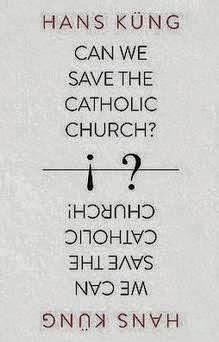
Three more passages from Hans Küng's book Can We Save the Catholic Church? (London: William Collins, 2013) that leap out at me as the U.S. Catholic bishops prepare to stage once again their Fortnight for Freedom freak show that is all about keeping the culture war alive in the U.S. to serve the interests of their anointed political party, the GOP:
Küng deplores the way in which the Catholic hierarchy has chosen, at this point in the history of the church, to declare war against secular culture insofar as the culture is outside the hierarchy's control, rather than engaging culture in fruitful dialog in which the Catholic community can learn from the best in secular culture while imparting its values to the culture:
It cannot be denied that hardly any major institution in Western democratic countries treats dissenters and critics within its own ranks so inhumanely. And none of them discriminates so strongly against women, for example, by prohibiting birth control, forbidding priests to marry, by prohibiting the ordination of women. No other institution polarizes society and politics on issues such as homosexuality, stem cell research, abortion, assisted suicide and the like. And while Rome no longer dares to proclaim formally infallible doctrines, it still envelops all of its doctrinal pronouncements with an aura of infallibility, as though the pope’s words were a direct expression of God’s will or Christ’s voice (47).
What grieves Küng is that the church need not have ended up in this bitter, losing, fruitless battle with secular culture following Vatican II, since Vatican II provided the church with a very different template for engaging culture — one that Popes John Paul II and Benedict XVI chose to destroy:
Although individual Christians can and often should take a public stand on contemporary issues, the Church as a community of faith and its representatives should take such public stands on controversial public issues only when the Gospel of Jesus Christ himself and the fundamental human rights and human responsibilities based on the Gospel are unequivocally in jeopardy or make an intervention mandatory; when this is not the case, it is better to show tolerance and patience and allow the matter to be settled by the slow process of consensus-building (257-8).
And, as a result, here's the kind of church we've ended up with due to the papacies of the two restorationist, anti-Vatican II popes, JPII and BXVI — to the great (and sinful) destruction of the whole church:
When I think only of the many such cases that have been reported to me personally, both in writing and orally, by people who have suffered during the 45 years of the Wojtyla-Ratzinger regime, I would need hundreds of pages to document the warnings, threats, subpoenas and disciplinary measures taken: arbitrary transfers, dismissals, impositions of silence, withdrawal of teaching and preaching licenses and suspensions from priestly office (294).
Institutions that want a bright future for themselves never decimate their intellectual class, drive off their thinkers, do in their poets and dreamers. This goes a fortiori for institutions that claim to be mission-driven, and whose mission is about reaching out to the world surrounding the institution and drawing that world into the circle of redemptive love.

